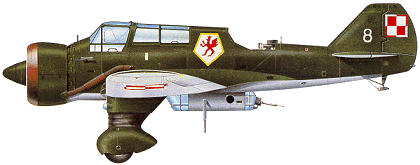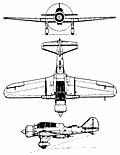|
| During 1931 P.Z.L. had designed a six-passenger single-engine light transport, the P.Z.L. P.13, for service with LOT, but as it had no appeal to the airline its development was abandoned. It was decided subsequently to use this aircraft as the basis for an army co-operation aircraft accommodating a crew of three, and using as powerplant a licence-built version of the Bristol Pegasus radial engine. Following evaluation of the design by the Department of Aeronautics, P.Z.L. was instructed to build three prototypes and the first, powered by a 440kW Bristol Pegasus IIM2, was flown for the first time in August 1934. This aircraft had the designation P.23/I and name Karas (crucian carp), but testing soon revealed a number of shortcomings. The two following prototypes, P.23/II and P.23/III had the engine mounting lowered to improve the forward view, the bomb bay was deleted to provide more room within the fuselage, and improved glazed canopies were introduced, together with a number of other improvements. The P.23/II crashed during flight trials, but the P.23/III performed well and during development flying was modified progressively to what was to be production standard. In 1935 production orders were placed for 40 examples of the P.23 Karas A with the 433kW P.Z.L.-built Pegasus II, and 210 of the P.23 Karas B with the 507kW P.Z.L.-built Pegasus VIII. The first P.23A Karas A flew in June 1936, but development problems with the Pegasus II engine resulted in these aircraft being relegated to the training role. However, the P.23B Karas B began to enter service in mid-1937 and when production ended the type equipped 14 first-line squadrons. One Karas B was modified under the designation P.42 to serve as a development aircraft for the improved P.46 Sum, with a twin fin/rudder tail unit and a retractable ventral gondola. However, the P.46 did not materialise beyond the prototype stage and the P.42 was subsequently converted back to Karas B standard. One other version similar to the Karas B entered production, however, as the P.43A Karas, of which 12 were built for the Bulgarian air force and delivered in 1937. This model differed by having the 694kW Gnome-Rhone radial engine, improved crew accommodation, and armament increased by the addition of a second forward-firing machine-gun. The excellent performance of the P.43A Karas led to repeat orders, totalling 42, for a further improved P.43B Karas with the 731kW Gnome-Rhone N.1. Of this total 33 were despatched and delivered by August 1939; of the balance, eight had been packed for despatch and the ninth was in final assembly. With the outbreak of World War II, these aircraft were seized for service with the Polish air force, but only five survived the initial German bombing attacks on the P.Z.L. factory and were flown off to serve with No. 41 Squadron, one of the 12 first-line squadrons then equipped with P.23B Karas B aircraft. These squadrons were responsible for the bulk of the bombing and reconnaissance operations of the Polish air force during the first 16 days of September 1939, but their aircraft were terribly vulnerable to German opposition and virtually 95% of them were destroyed in action.

| MODEL | P-23B "Karas B" |
| CREW | 3 |
| ENGINE | 1 x Bristol Pegasus VIII, 507kW |
| WEIGHTS |
| Take-off weight | 3525 kg | 7771 lb |
| Empty weight | 1928 kg | 4251 lb |
| DIMENSIONS |
| Wingspan | 13.95 m | 46 ft 9 in |
| Length | 9.7 m | 32 ft 10 in |
| Height | 3.3 m | 11 ft 10 in |
| Wing area | 26.8 m2 | 288.47 sq ft |
| PERFORMANCE |
| Max. speed | 320 km/h | 199 mph |
| Ceiling | 7300 m | 23950 ft |
| Range | 1260 km | 783 miles |
| ARMAMENT | 3 x 7.7mm machine-guns, 700kg of bombs |
 | A three-view drawing (728 x 938) |
| axxius, e-mail, 20.02.2013 19:19 @Barry: Romania got 19 Karas in 1939 when they evacuated from invaded Poland to neighboring neutral Romania. they were used with good results in Operation Barbarossa, on the Southern flank. reply | | Idaeus, 15.11.2012 13:21 to Klaatu83: originally it wasnt developed for ground-attack missions. High Command had the opinion these missions would be too costly, so it had to level-bomb targets in inderdiction-missions. For that the Aircraft got the Bombardier and the Gondola, although the engineer-team wasnt pleased with this modification, ordered from Infantry-Generals. Greets reply | | Klaatu83, e-mail, 03.07.2012 02:23 What was the point of installing a defensive machine gondola underneath the belly of an aircraft intended primarily for ground attack? Surely aircraft engaged in ground attack missions would spend the majority of their time operating at low altitudes, where they would be unlikely to come under attack from below by enemy fighters. It seems to me that the designers could have dispensed with the gondola, and increased the plane's considerably. reply | | Barry, 05.04.2011 18:44 A handful of Karas were received by Romania who refurbished them and put them into service with Romanian crews who used them in the German invasion of Russia. reply | |
| | mort_faucheur, 19.08.2007 03:20 200m.p.h. top speed? What a death trap for the brave crews ordered to fly it. reply | | tj, 17.07.2007 16:20 Good plane reply |
|
Do you have any comments?
|
| 
COMPANY
PROFILE
All the World's Rotorcraft
|








